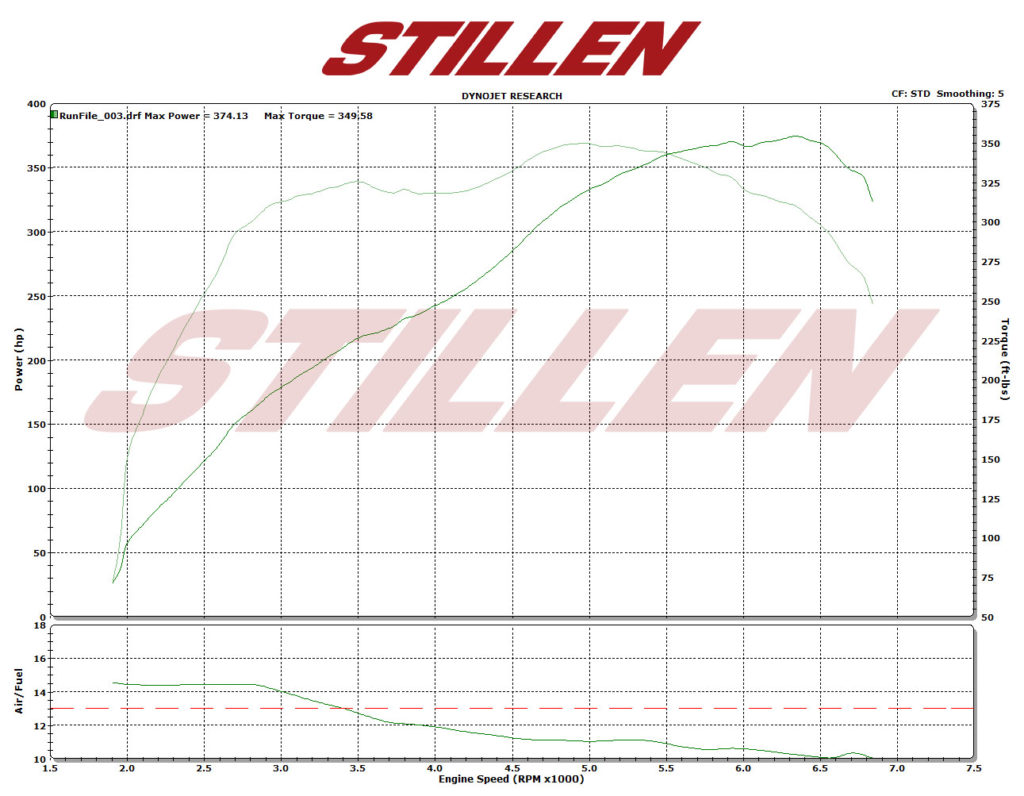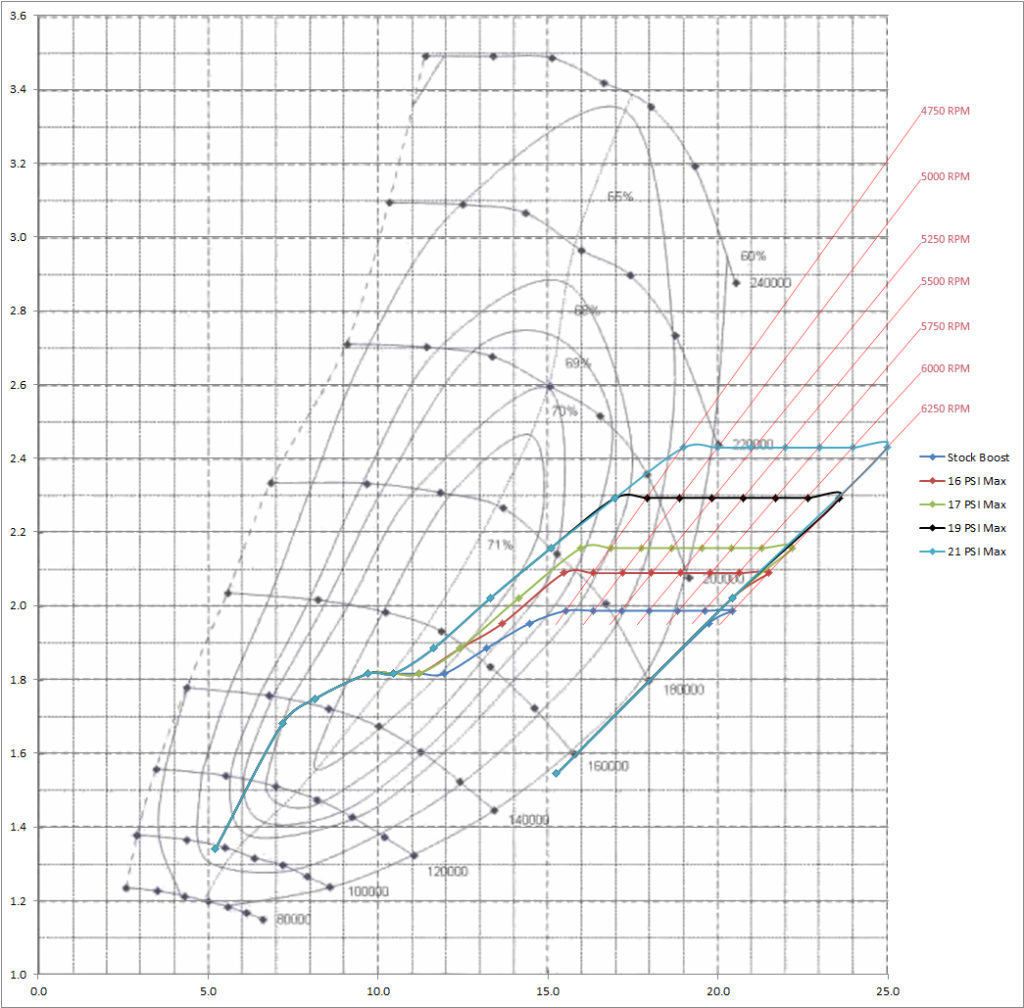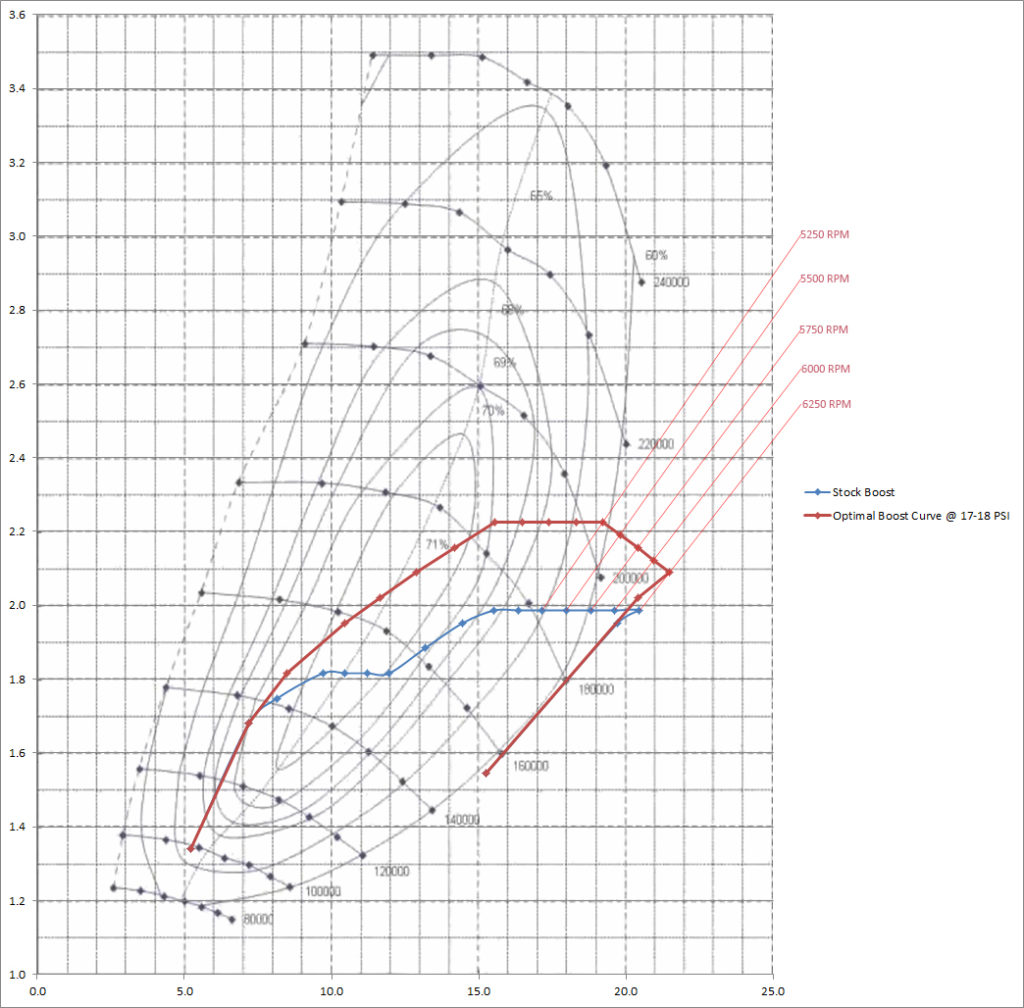The VR30DDTT is an impressive motor. It is underrated from the factory as we have seen with dyno testing. The Hi-Output version is rated at 400 hp and 350 ft-lbs at the crank and the Low-Output version is rated at 300 hp and 300 ft-lbs at the crank. We have consistently seen ~375 whp and ~350 wtq from the Red Sport Q50’s and Q60’s and ~300 whp and ~290 wtq from the “300 hp” versions.
That being said, everyone is still excited to see what these motors can do. With factory forced induction there is often a ton of room for gains when you simply tune the car and crank the boost up. Now there is a lot to consider before assuming power gains by simply increasing boost and tuning. So strap on your thinking caps and prepare for the math!
The factory turbos on the VR30 are produced by Honeywell-Garrett. The model of the turbo is MGT14446LKSZ. We could talk technical specifications*, but in the end let us just say the turbos are small. What is more important is we have the turbo map for the MGT1446 turbo. This has allowed us to see what efficiency range the turbos are operating under stock boost, as well as the limits of the turbos when it comes to boost levels and power gains.
We can see the VR30 Red Sport (400) boost curve looks something like this. With this knowledge, we can run a series of calculations to see the efficiency of the turbos throughout the RPM range.
For everyone who would like to do the math themselves the basic formulas are as follows.
Cubic Feet/Min:

Corrected Air Flow (CAF) lbs/min:

Pressure Ratio (PR):

So for stock boost our table will look like this:
*we use 1.5 liters as displacement as only half the motor feeds each turbo.
Q50 Red Sport – Stock (14.5 PSI)
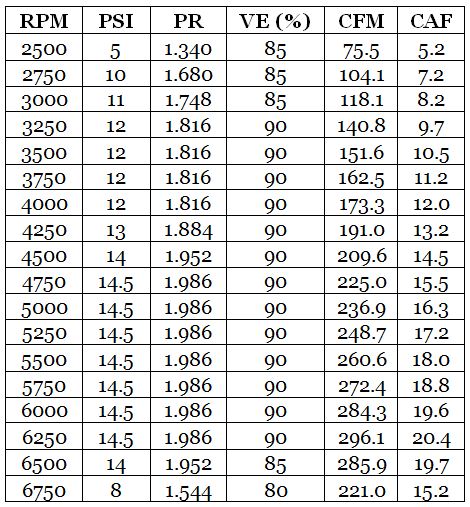
Utilizing the same formula and increasing boost, we made a graph then overlaid onto the Turbo Map. We included the Low-Output graph for reference as well.
You can see that even at stock boost (for the Red Sport) the turbos are off the efficiency island (below 60%) post 5750 RPM. So what happens as you move off the island? As turbo efficiency goes down you begin to generate more and more heat for the given boost pressure.
If you look at the stock dyno sheet, you can see where the horsepower curve begins to flatten out at around 5000 RPM. We have also seen with an aftermarket exhaust and secondary cat deletes the gains past the 5000 RPM area are far less significant. This can pretty much all be attributed to the turbos.
We went ahead and also did graphs of increased boost pressure following the factory curve up to max pressure. We assume the lower boost pressure below 4000 RPM is to keep the torque under control for driveability’s sake.
Looking at the chart, one can see that as you increase the maximum boost levels you move out of the efficiency island very quickly. At 17 PSI you move below 60% efficiency at 5500 RPM which is not much worse than stock. However, once we get into the 19 PSI Range you can see us leave efficiency by 5250 RPM. On top of that we are moving over 23.6 lbs/min (or 342 CFM) at 6250 RPM very far outside of the efficiency island. This puts a lot of stress on both the engine and turbos.
So aside from changing the turbos (which there are no upgrades available at this time), what can we do to safely increase power? We believe it is unwise to spin these turbos much past 17 psi in search of a lot more power (at least above 5000 RPM). So with a moderate increase in boost pressure, the name of the power game will be EFFICIENCY (yes I’m sure you’re tired of reading that word).
Restrictions:
With any factory setup, there are going to be restrictions. Some are cost related, some are emissions related, and some are Noise/Vibration/Harshness (NVH) related.
We already know the first restriction point lies in the intakes. Factory intake systems are the first point of emissions and sound control on a car. The STILLEN intakes have already shown impressive gains in the mid-range powerband. This makes sense as the highest efficiency range of the turbo at factory boost levels (and even elevated boost levels) will be in the 3250-5000 RPM range.
The factory exhaust system on the VR30 powered cars is definitely a bottleneck as well. We know the secondary catalytic converters narrow down to 1.5 inches (diameter) just before the cat-back. On top of that the factory cat-back exhaust is a mere 1.75 inches (diameter). Now removing the factory catalytic converters is frowned upon by the EPA, so we can’t recommend changing those out. However, a cat-back exhaust is perfectly legal and voids no warranties (which we are sure most of you know). On top of giving the Q50 & Q60 the exhaust note it deserves, the cat-back greatly increases the efficiency of the turbos by reducing back pressure. This reduction in back pressure reduces the resistance on the turbines and in turn allows them to spool faster and easier. This means for the same given turbine speed, you are able to create more boost (or the same boost) with less heat.
Cooling:
While heat is necessary for an engine to run properly, too much is definitely a bad thing. While on a naturally aspirated motor, a cooler intake charge can greatly improve performance. Forced induction doesn’t yeild as impressive of results. Why is this? The air pulled through the intakes enters the turbo which compresses the air. The compression of air causes an increase in air temperature (see Boyle’s Law and Charles’ Law) which is problematic for internal combustion engines. With most forced induction setups there is an intercooler (or aftercooler) which is located between the turbo and the lower intake manifold. Said intercooler can be either an Air-to-Air or Air-to-Water system. The VR30 uses a pair of Air-to-Water intercoolers. The heat exchanger for the intercoolers (how the heat is removed from the system) is located in front of the radiator behind the grille.
The Red Sport version of the Q50 and Q60 both come with two waterpumps (push-pull) to increase cooling for the intercoolers. This makes sense as the Red Sport boost levels create a lot more heat at higher RPM than the 300 hp version. Knowing that many people will be increasing the boost of both models, everyone could definitely benefit from more cooling. While the intercooler units themselves would be difficult to upgrade since space in the engine bay is quite limited, the heat exchanger up front has some room to grow. Increasing the size of the heat exchanger does two things: allows for more heat to be extracted from the hot fluid, and increases the volume of fluid which increases the overall thermal capacity of the system. While this isn’t the ultimate solution, it would make running higher boost levels (17-18 psi) safer as well as reducing potential heat soak after prolonged aggressive driving.
Tuning:
While there is still a lot of exploring to do when it comes to tuning, there are several things we can see just by looking at the turbo map and dyno sheets. Your biggest gains will all be in the mid-range (2500-5000 RPM) with the stock turbos.
Based on the turbo map, tuning to 18 PSI from 4000-5000 RPM puts you in a very ideal efficiency range for the turbos. Now dropping the boost after 5000 RPM is important as holding too much boost is not ideal for the motor or turbos, but also won’t gain much additional power. This fine tuning of boost pressure adjustment is made easier by the factory electronically controlled wastegate actuators.
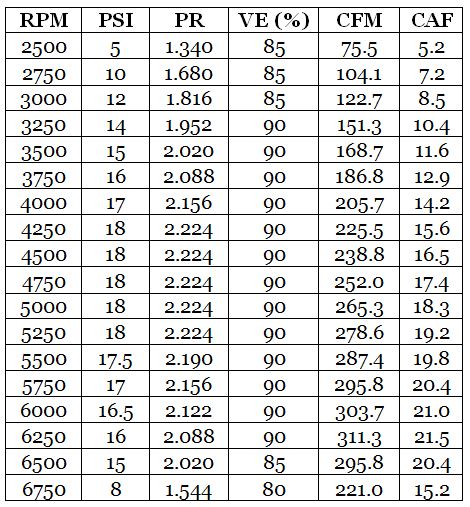
While we are still waiting on the tuning companies we work with to release official software, we are confident it won’t be much longer. You can bet we are just as anxious to start tuning these cars as you are, but with any new platform the best products take a little time to develop.
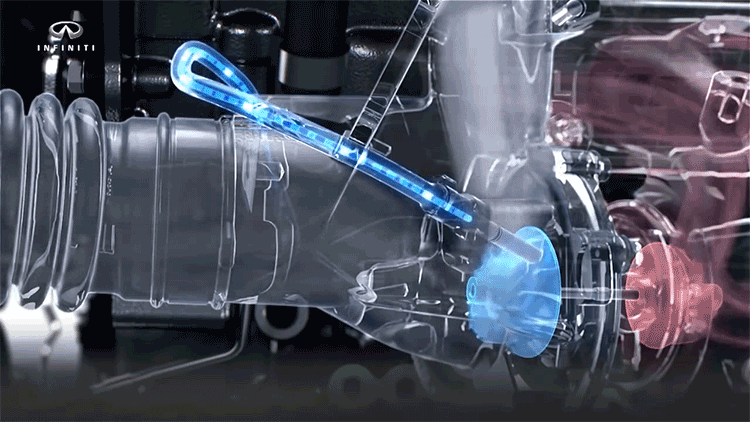
Although we probably won’t be seeing any 600 whp Q50’s or Q60’s without bigger turbos, there is still a lot of potential even on the factory units. Needless to say, we are all working on more ways to make power with this platform. STILLEN is about to release our new intake system for the 3.0t Q50 & Q60 along with our Cat-Back Exhaust for the 3.0t Q50! Our engineering department has done a lot of work on these products and designed them with the factory setup in mind as well as future upgrades. Stay tuned (pun intended)!
___________________________________________
*From the information we could find from Garrett:
Compressor side: TRIM 55 – A/R 0.46
Turbine side: TRIM 76 – A/R 0.40
Cooling: Oil and Water




